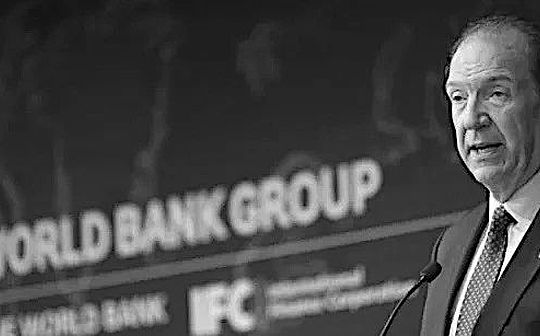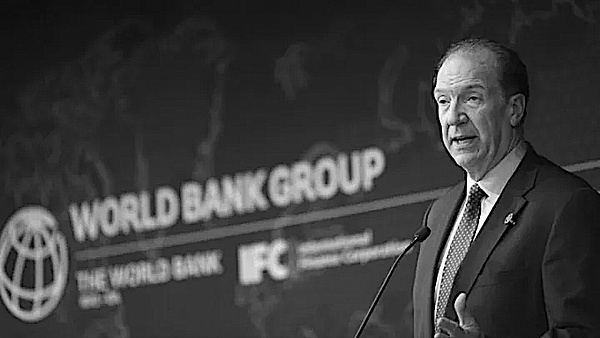
introduction
The U.S. Central Bank, the U.S. Federal Reserve (“Feder”) has been criticized for its policies accused of exacerbating the “silent depression.”This depression is manifested in the decline in real wages, excessive financialization, and the “K-shaped economy”, that is, Wall Street gets rich and the middle class is marginalized.Former World Bank President David Malpass and former Fed Director Kevin Warsh have proposed bold reform plans to shift the Fed’s policy focus to wage growth, small business support and reduce funding for fiscal deficits.However, their plans face significant trade-offs, including inflation risks and market instability.
This article analyzes their proposals, assessing their potential to revive the middle class, and combines key data and insights to explore risks in the context of the U.S. economic challenge.
Silent depression: a broken economic system
The U.S. economy has undergone profound changes since the post-World War II boom, when high nominal growth, strong industrial capacity and rising real wages define the prosperity.Today, the economy presents the following characteristics:
-
Real wages fall: Denominated in gold, the average hourly wage plummeted from 0.6 ounces in 2001 to 0.1 ounces in 2025, a drop of more than 80%, reflecting the serious erosion of purchasing power.Real wages are also stagnant relative to the M2 money supply, as currency expansion exceeds wage growth.
-
Overfinancialization: Since the 1980s, the S&P 500 (large companies) has far surpassed the Russell 2000 (small and medium-sized companies), highlighting the K-shaped economy where large enterprises flourish while small businesses struggle.Financial assets grow faster than GDP, and the net assets of the top 1% of the population far exceed economic growth.
-
Fiscal and trade deficits: The United States maintains a huge current account deficit and a fiscal deficit that worsened seven times from 2007, with federal debt interest payments exceeding $1 trillion per year (5% of GDP, close to an all-time high).
-
Low economic vitality: The rate of currency circulation (M2/GDP) has declined since the early 2000s, reflecting the stagnation of the real economy.Private banking credit creation lags behind GDP growth since 2008, with the Federal Reserve’s balance sheet (now 22% of GDP, historically 6%) filling that gap with quantitative easing (QE).
These trends have been exacerbated by globalization (such as China’s entry into the WTO in 2001) and the Fed’s quantitative easing policy, hitting the middle class hard, reducing housing affordability and concentrating wealth in the elite.Against this backdrop, Malpass and Wash proposed transformative reforms.

David Malpass: Turning the Fed’s focus to wages and growth
proposal
-
Prioritize real wage growth: Malpass advocates shifting the Federal Reserve’s mission from the 2% inflation target to real wage growth, measured by CPI, M2 or gold, aiming to reverse the decline in purchasing power over 25 years.
-
Targeted Credit Tool: He proposed that the Federal Reserve launch a credit program that supports small and medium-sized businesses (SMBs) to counter the dominance of large businesses.
-
Lower interest rates and boost growth: Malpass recommends lowering interest rates to reduce debt services costs (currently more than $1 trillion per year, accounting for 5% of GDP), while driving nominal GDP growth beyond debt costs, mimicking post-WWII deleveraging strategies.
Potential Benefits
-
Middle class revival: Pay attention to the possibility of real wages to restore purchasing power, such as during the period of high nominal growth (real GDP + inflation) after World War II, real income and currency circulation speed increased.From 1945 to 1980, real personal income grew strongly, and financial assets performed worse than GDP, benefiting the bottom 90% of the population.
-
Small and medium-sized enterprise support: Targeted credit leveles the playing field for small and medium-sized businesses that employ 46% of the U.S. workforce (Small Business Administration, 2023).This may stimulate employment and local economic activity.
-
Debt reduction: Keeping debt costs below nominal growth can reduce the proportion of debt to GDP, such as after World War II debt dropped from 120% in 1945 to 30% in 1980.
Risks and Challenges
-
Inflation risks: Higher nominal growth usually brings inflation.Although Malpass envisions wage growth (e.g. 6-7%) exceeding inflation (e.g. 4-5%), historical data show that inflation often erodes real wages.From 2001 to 2025, CPI inflation averaged 2.5% per year, but real wages fell due to currency depreciation.
-
Bond market resistance: The bond market will adjust yields to reflect nominal growth expectations.Forced lowering of yields through quantitative easing or yield curve control may lead to financial suppression, and bondholders suffer actual losses, which may trigger market volatility (such as bond yields soaring during the 2025 period of Trump-Powell’s test of the balloon).
-
Structural limitations: Unlike after World War II, the United States now lacks industrial capacity, continues to operate trade and fiscal deficits, and is overly financialized.These limit the effectiveness of Malpass’ strategy, as nominal growth may drive up asset bubbles rather than real economy growth.

Kevin Wash: Reduce the role of the Fed
proposal
-
Reduce the impact of the Federal Reserve: Wash criticized the Fed’s balance sheet for being too large and its role in funding deficits through quantitative easing.He advocates reducing its size and focusing on core monetary policy.
-
Stricter inflation targets: Wash proposed setting a fixed inflation target of 1-2% or following Taylor’s rules, abandoning the Fed’s current flexible, data-dependent approach.
-
Regulatory reform: He called for curbing the Fed’s over-regulatory oversight (such as ESG mandate) and prioritizing monetary stability over social goals.
Potential Benefits
-
Financial discipline: Reducing quantitative easing could force Congress to address the $2 trillion annual deficit (7% of GDP, CBO 2025 estimates) to stabilize long-term debt dynamics.
-
Market Stable: A clear 1-2% inflation target can stabilize expectations and reduce volatility.Taylor’s rules link interest rates to inflation and output gaps, providing predictable policies.
-
Easing wealth inequality: Shrinking the Fed’s balance sheet may slow down wealth inequality driven by quantitative easing, which has led the net assets of the top 1% (300% growth since 2008) far exceeding GDP growth (80%).
Risks and Challenges
-
Economic slowdown: Reducing the role of the Federal Reserve may tighten credit conditions and slow growth.Since 2008, private bank credit generation has dropped by 20% relative to GDP, and quantitative easing has filled this gap.Without quantitative easing, small and medium-sized businesses and consumers may face higher borrowing costs.
-
Deficit financing issues: The Federal Reserve’s reduction in Treasury purchases may push up yields and increase debt service costs.In 2025, a 1% rise in the 10-year Treasury yield could increase annual interest expenditure by $300 billion (Treasury data).
-
Policy conflict: Wash’s call for lower interest rates to stimulate growth contradicts his goal of narrowing the Fed, as lower interest rates usually require quantitative easing or yield curve control to expand the balance sheet.
Shadow Fed and political background
The incident in 2025 that Trump drafted a letter to fire Fed Chairman Jerome Powell highlighted the huge political pressure on reform.The concept of “shadow Fed” – announcing a new chairman in advance to indicate a policy change – may affect the market ahead of time.The market responded sharply to Powell News, with the dollar falling 2%, the 10-year Treasury yield rising 50 basis points, and the stock market fell 3% (Bloomberg, July 17, 2025).Although the government subsequently withdraws, Powell’s term will end in May 2026, paving the way for the new chairman to implement reforms.
Malpass and Wash’s philosophy echoes the structural change described by Strauss and Howe.After World War II, the 1951 Fed-Treasury Agreement granted the Fed independence, but the current proposal of yield curve control or large-scale quantitative easing may reverse this situation, echoing the Fed’s policy in the 1940s to suppress yields for bond financing.
Trade-offs and feasibility
Malpass and Wash’s goal is to resolve the silent depression, but their proposals are inherently conflicted:
-
Quantitative easing and shrinking the Fed: Lowering interest rates to stimulate growth requires quantitative easing or yield curve control, which will expand the Fed’s balance sheet, contradicting Wash’s goal of narrowing the Fed.Quantitative easing has also exacerbated wealth inequality, with the net assets of the top 1% growing by three times that of GDP since 2008.
-
Inflation and wage growth: High nominal growth may trigger inflation and may erode wage growth unless properly managed.After World War II, real GDP grew by 4% annually, and wage growth exceeded inflation.Low productivity today (1.5% per year in 2025, BEA data) makes this even harder to achieve.
-
Market Stability and Reform: Forced lower yields below nominal growth may trigger market turmoil as bondholders demand higher returns.Powell’s tentative balloons in 2025 show the market’s sensitivity to Fed uncertainty.
Viewpoint: Necessary but risky reforms
Malpass and Wash’s proposals are a welcome change to the Fed’s focus on inflation and technical practices in financial markets.To address real wages and small and medium-sized enterprises, it may solve the middle class’s dilemma and reverse the decline in purchasing power and the K-shaped economy over the past 25 years.However, the risks are high.Quantitative easing-driven growth disproportionately benefits the rich, suppressing bond yields may trigger inflation or market instability.The structural weaknesses of the United States—trade deficits, low productivity, and excessive financialization—limited the applicability of the post-WWII model.
A balanced solution may include:
-
Mixed Mission: Combining the inflation target of 1-2% and the actual wage growth indicator, ensure that the policy benefits workers without undermining price stability.
-
Directed Qualified Easing: Limit quantitative easing to credit instruments for small and medium-sized enterprises, minimize asset price inflation, and support the real economy.
-
Financial coordination: Combining Fed reforms with fiscal policies that increase productivity (such as infrastructure investment) and reducing deficits to address structural restrictions.
If implemented improperly, these reforms may exacerbate inequality or inflation, but indifference will deepen the silent depression.The Fed must evolve to prioritize the middle class, but the navigation of tradeoffs will be a daunting challenge.
in conclusion
Malpass and Wash offer a bold vision for reforming the Federal Reserve to address the impact of the silent depression on the middle class.Their focus on real wages, SME support and a streamlined Fed may restore economic equity, but inflation, market volatility and structural restrictions pose significant risks.With Powell’s term ending in 2026 and the United States approaching a potential turning point, the next Fed chairman will face a delicate balance.The road ahead requires innovative policies, fiscal discipline and commitment to forgotten American workers—or the silent depression will deepen further.





